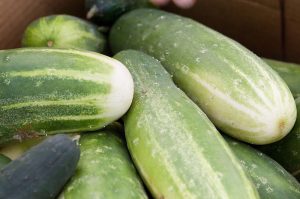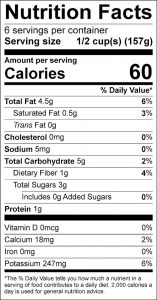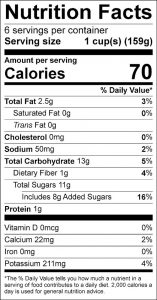Bulletin #4254, Vegetables and Fruits for Health: Cucumbers

Developed by Extension Nutrition Specialist Nellie Hedstrom, University of Maine Cooperative Extension.
For information about UMaine Extension programs and resources, visit extension.umaine.edu.
Find more of our publications and books at extension.umaine.edu/publications/
Fresh from the garden, cucumbers are a welcome addition to any Maine table. Served in a variety of ways, the distinctive crisp, cool vegetable will add extra crunch, whether in a sandwich or in a favorite salad.
Two basic types of cucumbers are common in Maine gardens: slicing varieties for eating fresh, and pickling varieties. The slicing cucumbers are longer, usually about nine inches long, have dark green skin, and are glossy with tapering ends. The pickling varieties are smaller and squatter. They have a lighter skin and are bumpy. You will also see greenhouse-grown slicing cucumbers in the supermarket. This variety originated in Europe and is called a European or English cucumber.
Nutrition Information
The water content of cucumbers is high, which is why the calorie content is so low. A whole cup of sliced cucumbers has only 13 calories. As one might assume, the protein, carbohydrate and fat content is also low. Cucumbers supply texture and variety to meals and make wonderful snacks.
Selection
When selecting cucumbers at the farmers’ market or vegetable stand, look for those that have been kept cool or stored in the shade. Supermarket cucumbers should be displayed in a cooled case. Avoid cucumbers that are shriveled and withered. Also avoid those that have bulging middles. Overripe cucumbers, with large seeds and watery flesh, will have poor taste. Slender, firm, dark green cucumbers will taste the best. Bruises and dark spots on cucumbers are signs of decay.
Storage
Cool storage is recommended. From the garden or market, store the unpeeled cucumbers in your refrigerator crisper. If cucumbers have a wax coating, store them in the crisper and use within a week. Unwaxed, store-purchased cucumbers will not keep as long. Keep peeled cucumbers wrapped tightly in plastic wrap and store in the cool part of the refrigerator. Use within one or two days.
Preparation
Wash all cucumbers before cooking or eating. If cucumbers have been post-harvest treated with a wax coating, peel them before using. Cooking cucumbers by heating is common in some regions of the country. The vegetable’s delicate flavor will complement meat dishes. Some recipes call for scooping out the seeds and just using the flesh. Seasoned with herbs and other dressings such as lemon, dill, tarragon, or mint, adds taste. In Maine, cucumbers are served more often uncooked, straight from the garden, in a salad or with a meal.
Cucumber Soup
Add julienne cucumbers to a boiling, well-seasoned broth and cook for 45 seconds to one minute. Remove from heat and serve while cucumbers are still crisp.
Quick gazpacho
Stir together tomato juice, chopped cucumbers, bell peppers, scallions, and garlic. Refrigerate until well chilled.
Gazpacho
Serves: 6 (1/2-cup servings)
1 clove garlic
1/2 small onion, quartered
1/2 green pepper, cut in chunks
3 tomatoes, quartered
1 cucumber, cut in chunks
2 tablespoons vinegar
2 tablespoons olive oil
1/2 cup water or chicken stock
Salt and pepper to taste
In a blender, blend onion and garlic. Turn machine off and add the other vegetables, vinegar, and oil. Blend only until the vegetables are chopped. If the soup is too thick, add the water or stock. Cover and refrigerate until serving time. If needed, add salt, pepper, and more vinegar. Serve cold.
Spicy Cucumbers With Yogurt
Serves: 4 (1/2-cup servings)
1 medium cucumber, peeled, seeded, and thinly sliced
1 cup plain fat-free yogurt
1 1/2 teaspoons hot chili peppers, minced
1/8 teaspoon cumin
Salt
Dash cayenne pepper
Combine the first four ingredients in a medium bowl. Season to taste with salt and cayenne pepper. Toss to mix. May be made up to 4 hours ahead of serving.
Cucumbers Vinaigrette
Serves: 6 (1-cup servings)
8 cups cucumbers, sliced and unpeeled
1/4 cup sugar
1/4 cup cider vinegar
1 tablespoon olive oil
1/8 teaspoon salt
Combine all ingredients in a serving bowl; toss well. Cover and chill for 2 hours.
Some content adapted with permission from University of Massachusetts Cooperative Extension.
Information in this publication is provided purely for educational purposes. No responsibility is assumed for any problems associated with the use of products or services mentioned. No endorsement of products or companies is intended, nor is criticism of unnamed products or companies implied.
© 1997, 2005
Call 800.287.0274 (in Maine), or 207.581.3188, for information on publications and program offerings from University of Maine Cooperative Extension, or visit extension.umaine.edu.
In complying with the letter and spirit of applicable laws and pursuing its own goals of diversity, the University of Maine System does not discriminate on the grounds of race, color, religion, sex, sexual orientation, transgender status, gender, gender identity or expression, ethnicity, national origin, citizenship status, familial status, ancestry, age, disability physical or mental, genetic information, or veterans or military status in employment, education, and all other programs and activities. The University provides reasonable accommodations to qualified individuals with disabilities upon request. The following person has been designated to handle inquiries regarding non-discrimination policies: Director of Equal Opportunity and Title IX Services, 5713 Chadbourne Hall, Room 412, University of Maine, Orono, ME 04469-5713, 207.581.1226, TTY 711 (Maine Relay System).




